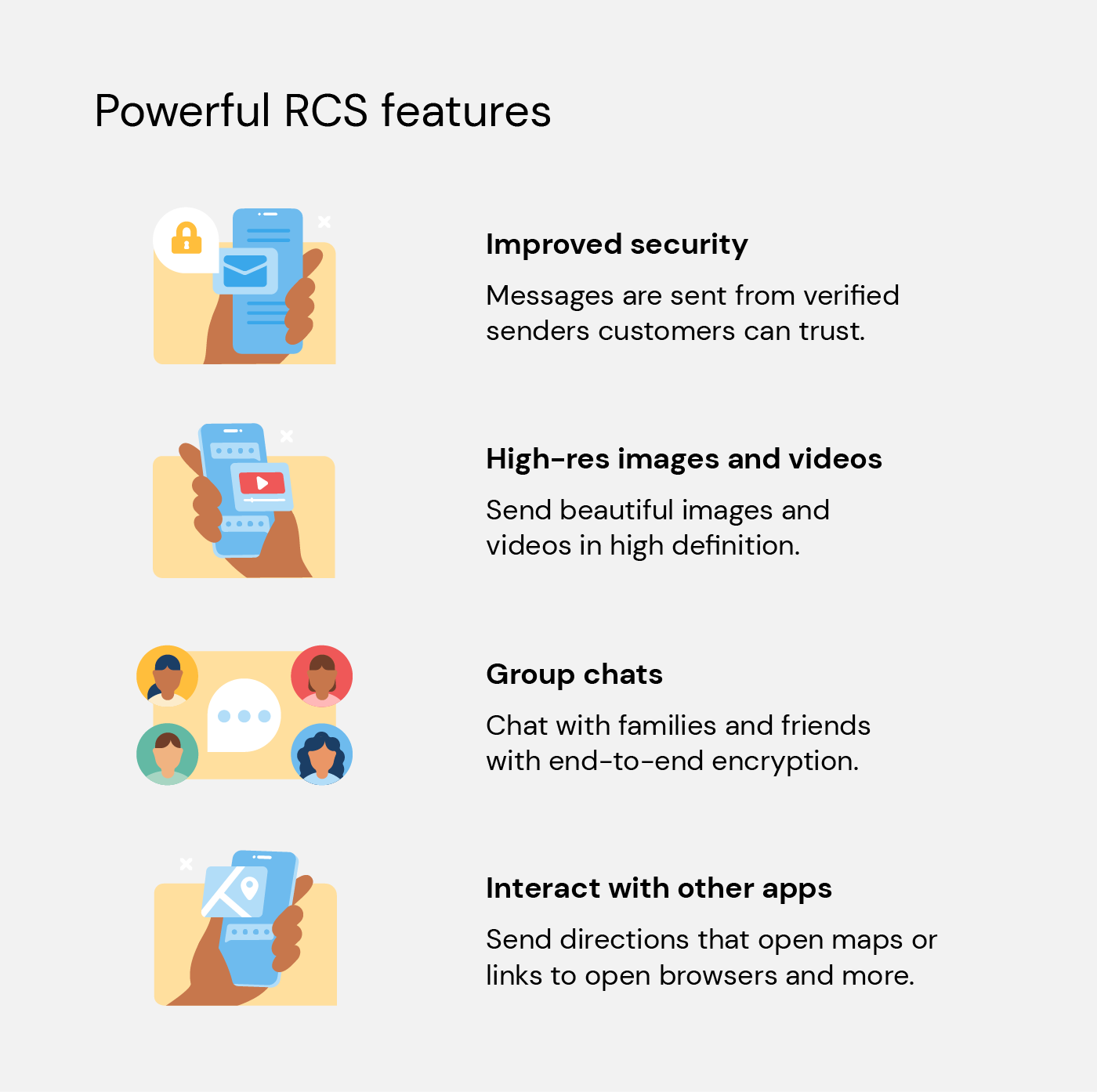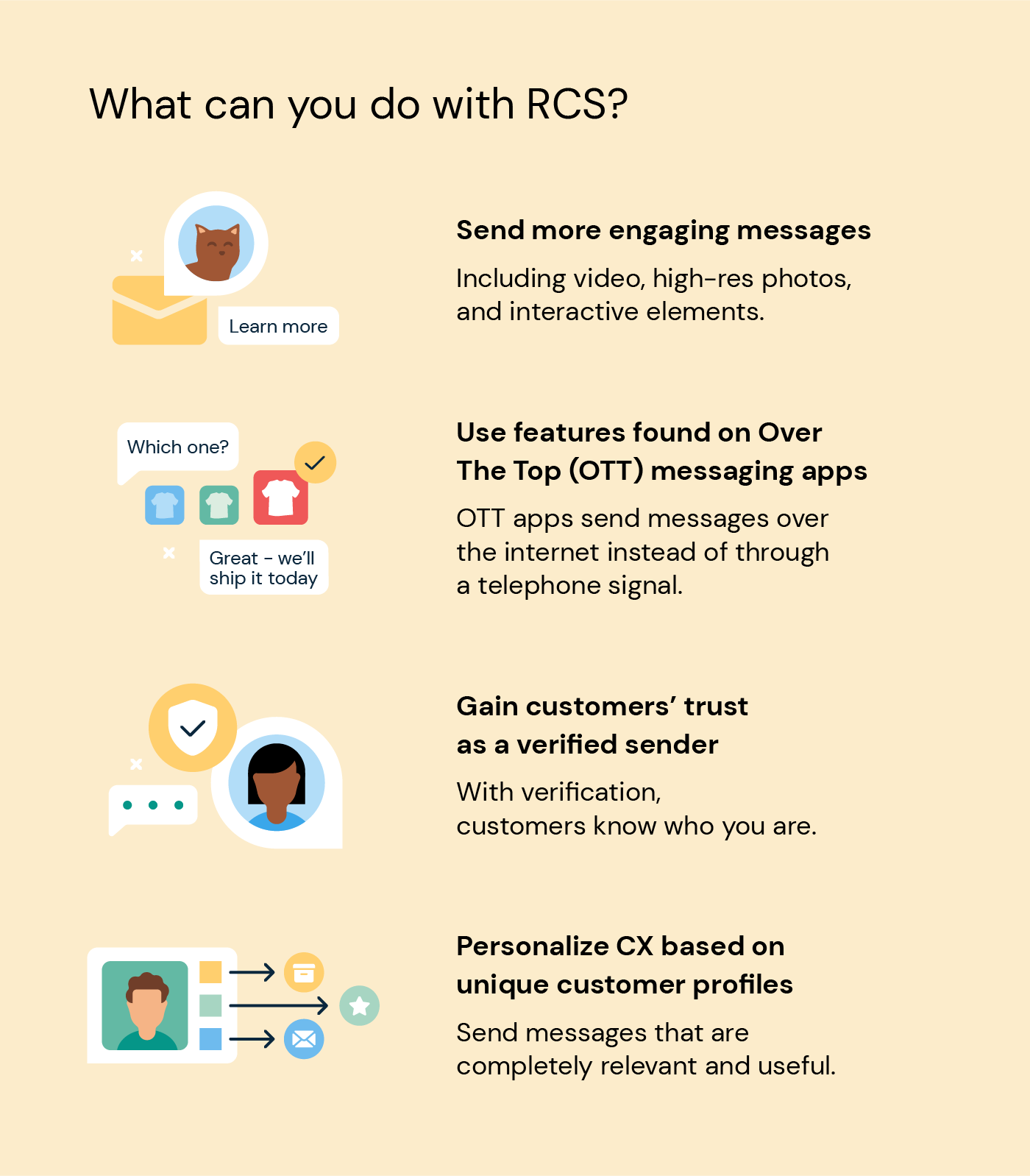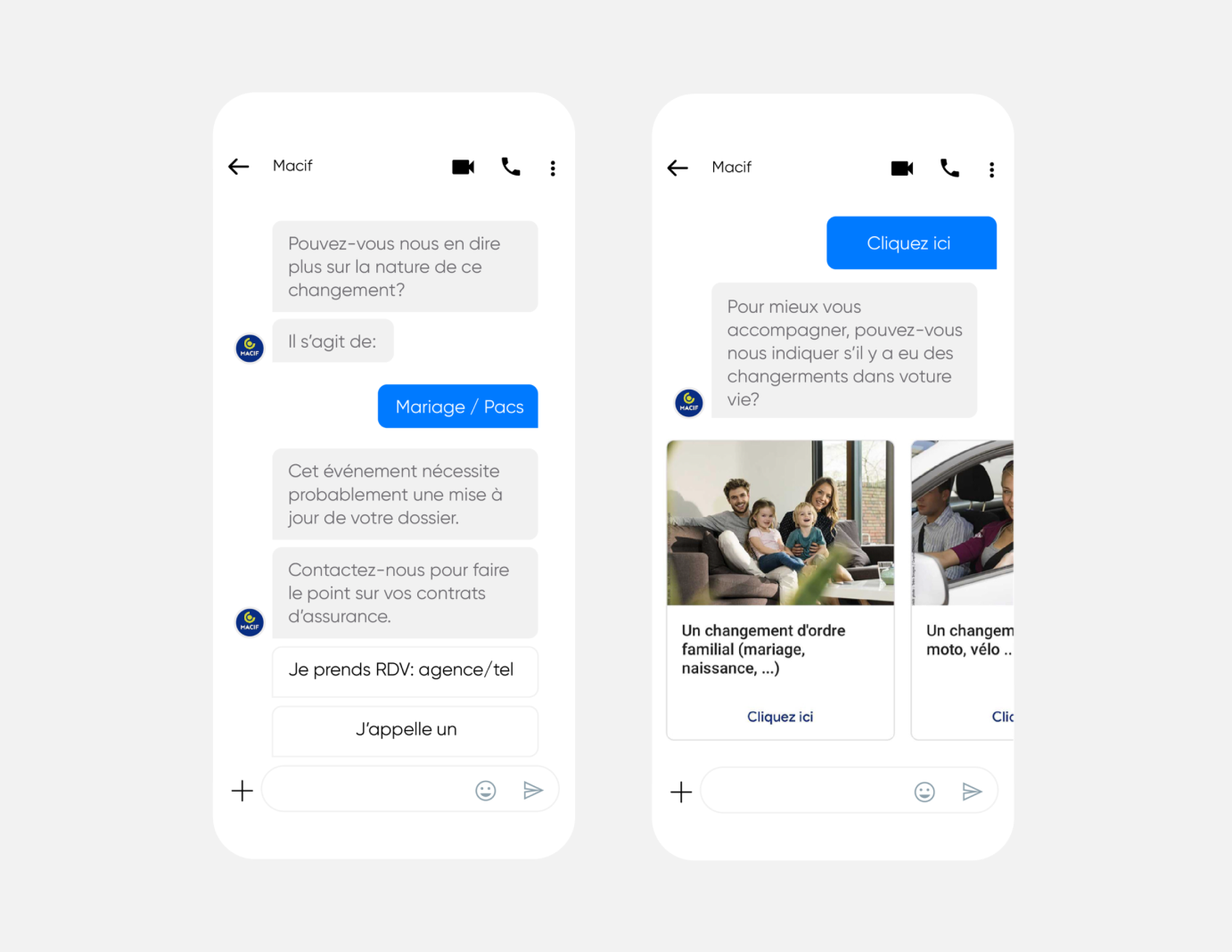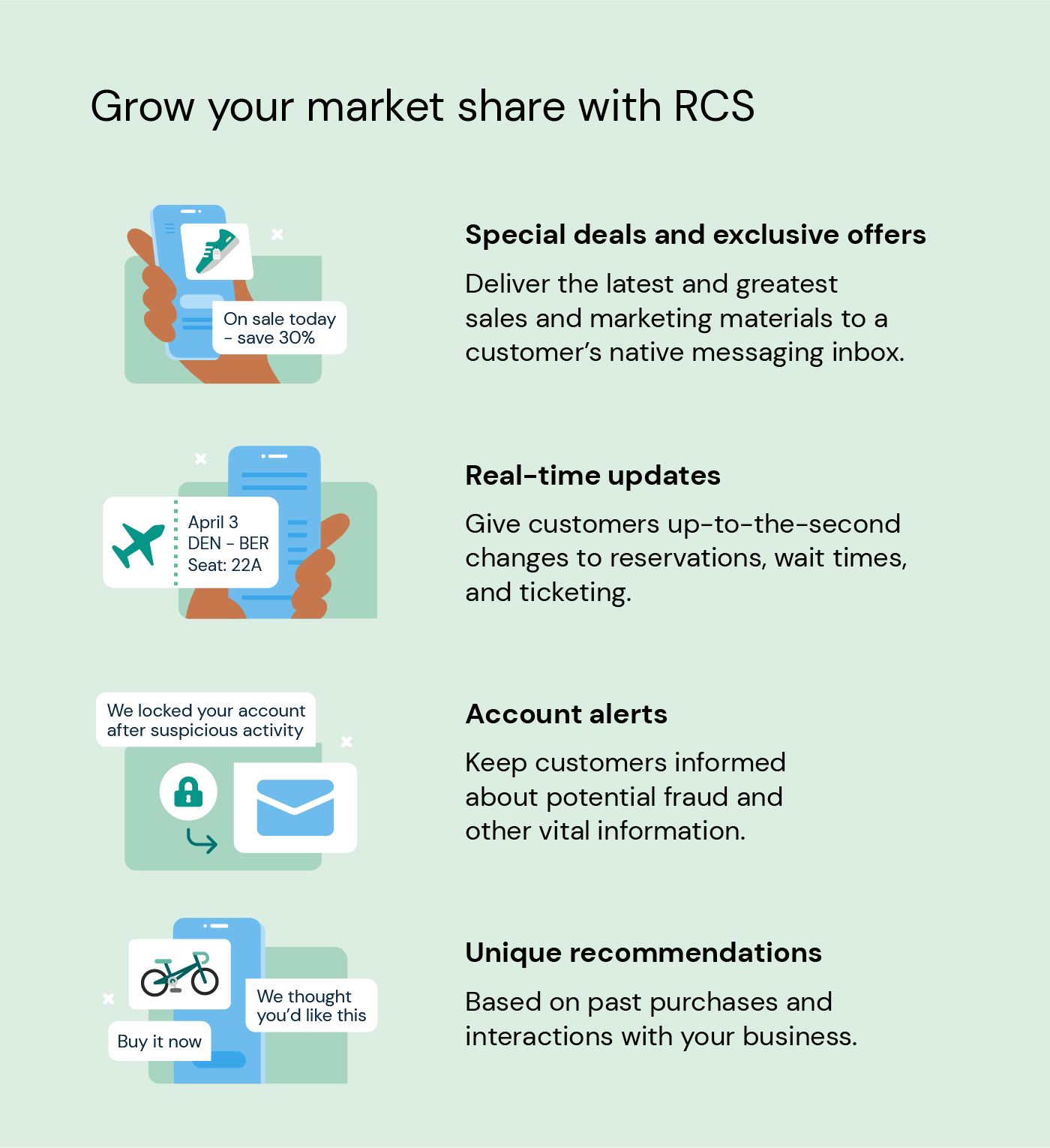In this article:
- What is RCS messaging?
- Where is RCS messaging used?
- RCS vs. SMS and MMS vs. OTT messaging apps
- Exciting rich communication services features
- Why RCS chat is a game-changer for your company and your customers
- How RCS messaging can grow your business
- 3 tips to build a great RCS strategy
- Getting started with RCS messaging
While billions of people send texts each year, there are other messaging channels that offer a lot more, like Rich Communication Services (RCS). But what is RCS messaging and how does it work?
RCS was built as a replacement for SMS. It allows Android users to enjoy many of the same features as those using Apple’s iMessage system. While RCS was first conceived 15 years ago, its widespread adoption has grown more recently, with more than one billion monthly active users with RCS messages enabled and full coverage from operators in 10 countries.
How is this good for your business? Let’s walk through how you can use RCS for better engagement and sales, and gain customer trust.
What is RCS messaging?
RCS is a messaging protocol for Google/Android users with chat features that are similar to Apple’s iMessage.
In RCS chats, live chats that include multimedia (think a web browser, maps, and other images) can take place between businesses and the user’s native inbox (like Android Messages).
More people than ever are using SMS, and the biggest advantage it has over other messaging services is that it's available on any mobile phone. However, it does have its limitations (the first text was sent in 1992!). That's why, in 2006, the GSM Association (GSMA) set out to create the next step or evolution of SMS — RCS.
RCS was designed to upgrade SMS for modern systems and needs. That means more options, images, videos, and better security.
Sinch’s Robert Gerstmann said that one of the potential powers of RCS is that it can replace apps altogether. While that may sound radical, it is possible. Many of the most common uses of apps (checking balances, placing orders) could be handled with rich messaging. Plus, the security required for a company to get verified builds consumer trust, making them more likely to engage on that channel.
RCS chat is a communication protocol provided by Google for Android devices that empowers users with advanced communication features and capabilities like read receipts, typing indicators, high-quality media sharing, and more. This makes it a versatile, secure option for modern messaging.
Is RCS chat only for Android phones? Will Apple/iOS ever adopt RCS?
Apple doesn’t currently support RCS chats on iOS, but at WWDC24 in June 2024 Apple confirmed that RCS messaging would be supported in its Messages app in the iOS 18 update available in fall 2024.
While Apple was initially hesitant to adopt RCS, an Apple spokesperson in 2023 said the company ultimately believes RCS will offer better interoperability for cross-platform messages.
Later next year, we will be adding support for RCS Universal Profile, the standard as currently published by the GSM Association. We believe RCS Universal Profile will offer a better interoperability experience when compared to SMS or MMS. This will work alongside iMessage, which will continue to be the best and most secure messaging experience for Apple users. -Apple spokesperson, 9to5Mac, November 16, 2023
And after iOS 18 has been released, Robert Gerstmann shared how quickly RCS chats could be adopted by iPhone users.
"For previous versions of iOS, we have seen over 50% of all iPhones having the newest iOS version by winter, with that number increasing to 80% by the subsequent summer. If the adoption speed of iOS 18 matches that of previous iOS versions, this would translate to over one billion additional RCS users by summer 2025 thanks to Apple coming onboard.” - Robert Gerstmann, Chief Evangelist and Co-Founder at Sinch
While Apple has been light on the details and has only said that RCS messaging will be available in iOS 18, we're excited by the prospect of it adopting RCS for business messaging later in the year.
Where is RCS messaging used?
RCS has full coverage in the USA, Canada, Mexico, Brazil, UK, Germany, France, Spain, Italy, and India. Other countries offer full support via Google’s RCS services or partial support, with a selection of local mobile operators providing RCS.

Map shows markets where RCS has some level of operator coverage, no operator coverage, or unique deployments.
Android has more than 70% of the global market share, which means engaging Android users with the best, most interactive messaging available is a smart move.
RCS vs. SMS and MMS vs. OTT messaging apps
To understand the differences between RCS and text messaging, it might be helpful to first understand the differences between MMS and SMS.
The primary difference is that, while MMS messages allow for multimedia attachments, RCS offers a much more interactive experience. RCS messages work with other elements of a smartphone, like a web browser, maps, and other apps, to offer the engaging experiences that consumers are yearning for.
So, does that mean that RCS will actually replace SMS? Probably not. RCS was created to replace SMS as a messaging protocol, but RCS messages require a mobile data connection. That's why RCS can offer features similar to other OTT (over-the-top) messaging platforms like Facebook Messenger, WhatsApp, and others. But unlike OTT apps, RCS doesn’t require users to download an extra app or create a new account. RCS works with the native messaging app that’s built into Android devices.
SMS messages are still sent over a mobile network, meaning it can and should be used as a fallback when there's no Wi-Fi or you don't have a data plan (this is exactly what the Google Messages app already does between RCS and SMS).
Exciting rich communication services features
What does RCS do better than SMS texting? Well, just about everything!
- Better security, better branding: Fully verified sender IDs means that mobile subscribers always know exactly who they’re talking to. Secure, branded messages build trust and drive better engagement. Plus, RCS chats in Google Messages support end-to-end encryption, offering an extra level of security.
- Higher text limits: SMS messages are limited to 160 characters, while RCS messages don't have a character limit.
- High-resolution images and videos: Grab attention with gorgeous high-resolution photos and videos, gifs, carousels, and other dynamic features right in the native messaging app.
- Larger files: Send images up to 2 MB and videos up to 10 MB in size.
- Read receipts: If the recipient has their read receipts enabled, you'll see the word "Read" along with the time they read your RCS message.
- Cross-app connectivity: Send messages that open in browsers, maps, and other applications.
- Easy, one-tap replies: RCS messages offer suggested replies customized to your brand.
- Group chats: Connect securely in group messages with friends, family, and team members without requiring another chat app.
- Google Wallet integration: Provides a quicker and easier way to access everyday essentials.

Why RCS chat is a game-changer for your company and your customers
RCS lets you build more engaging content and provide a better CX for those with RCS-enabled devices. Time and time again, RCS has been proven to lead to higher cart values, more conversions, and higher engagement than any other type of mobile messaging.
User-focused features
What does RCS mean for users? A better customer experience, more options, and increased security when messaging.
Here are a few more benefits of RCS to user experience:
-
Verified senders: Users won’t have to worry about whether or not a message sent by a brand or enterprise is legit when it’s sent through RCS.
-
No extra downloads: All new Android devices have built-in RCS, so messages from verified businesses can go to the native messaging inbox instead of needing a separate app.
-
Message reactions, read receipts, and typing indicators: These features were once only found in Apple’s iMessage ecosystem, but now they’re available on Android, too.
-
Larger file sharing: Sending different kinds of files is easier when you don’t have to use email or send it through another system.
Verification builds trust
To be able to send RCS messages, businesses must be verified. This process reduces spam and increases trust in verified senders. Recently, Google announced that RCS Business Messaging will replace Verified SMS in another step towards making RCS the new standard.
For your customers, when they know that you’ve been verified, they can trust the messages that they get from you.
More features mean better engagement
Interactive and personalized features (as well as multimedia messaging assets) mean better engagement. Instead of sending a link to a product on your site or directing a customer to your online booking portal, you can do it right in the message.
When you make things as easy and fast as checking your texts, people will take advantage of what you offer them. For example, you can send RCS messages that contain elements like buttons with suggested actions. This saves time and helps direct customers towards actions that will solve their problems.
It’s also possible to send carousels of images, each of which have their own unique CTAs. If you’re helping a customer find a product they want or assisting them with booking an appointment, this is a huge time saver that they’ll appreciate.
Better reporting
Thanks to built-in analytics, you’ll be able to see who’s reading your messages and who isn’t. Handset delivery receipts, open rates, and read rates give you more in-depth information about the status of messages. Knowing when, where, and if your messages are being delivered will help you keep tabs on the performance of your messages.
Another benefit of better reporting is more data to use — which means better campaigns. Using the data from multiple campaigns, you can analyze them to see which parts of the message customers reacted to. Having these data points allows for better, more focused A/B testing opportunities.
Personalized UX
Personalizing your messages for individual users isn’t just a dream anymore. By using chat histories, analytics, and other data, you can design better customer profiles. With better profiles, crafting compelling messages for automated responses or designing better marketing materials suddenly gets much easier.
Reliable fallbacks
What happens if someone doesn’t have strong enough service or connection to WiFi when you send them an RCS message? The messages will then be delivered through a fallback protocol or another app, including SMS, MMS, or WhatsApp. In short, your messages will always get to your customers, one way or another.

How RCS messaging can grow your business
Like most other kinds of marketing and support, the ability to grow your business using RCS is only limited by your imagination and your budget. It’s good to remember just how powerful these messages can be — do you know any other form of outreach that’s as big a part of your customers’ daily routine as their text inbox? Neither do we.
Promotions and specials
Provide up-to-the-minute information on sales and promotions tailored to a customer’s tastes. With the added functionality of RCS, you can send them to your website, or give them directions to your location. You can even have them choose what they want and order it right from your message!
Here’s a real-life example: Macif, an insurance company with over 5 million policy holders in France, used RCS to have two-way conversations.

Macif’s campaign re-engaged contacts and increased campaign click-through-rate by 100%!
Real-time updates
RCS allows your customers to engage with a conversational service (including live support or AI chatbots), for instance, to schedule or change appointments. You can also provide directions, sports scores, and shipping updates as they happen.
Account alerts
One of the most powerful ways to use RCS is to send account alerts. While many of these alerts have been limited to SMS or apps in the past, now you can send fraud alerts, payment posting messages, and service reminders right to your customers’ message inbox, with links and options for how to proceed.
Personalized recommendations
Personalization is one of the most important parts of any communication or marketing strategy. Rich messages built around unique customer profiles lead to better engagement and sales. Create a profile for your customers based on past purchases and behavior to provide relevant, helpful recommendations.
Here’s another real-world RCS messaging example at work: Picard used an RCS campaign to lift sales and win customer loyalty. They created a conversational RCS experience that helped their customers imagine their holiday menus, taking into account dietary preferences, budget considerations, and even their desire to cook.
Watch the video to learn how Picard used RCS to personalize their customers' shopping experiences.
Their campaign achieved great results, with a 42% increase in customer engagement and 10% more clicks to the website than Rich SMS.

3 tips to build a great RCS strategy
A good RCS strategy is similar to SMS, push notification, and other mobile strategies. But it’s also different because it combines a lot of the features found in other channels into one.
Know what problems you’re solving or what you’re trying to communicate
Don’t send RCS messages without a specific purpose. Whether you’re giving access to a sale or sending an account alert, you need to make every message actionable. Luckily, the advanced features of RCS lets you create powerful CTAs. Segmenting messages by type is a good place to start:
- Informational messages: These can be fraud alerts, account balances, 2FA messages, or any other communication that provides information customers have asked for or need to be aware of.
- Marketing or transactional messages: With these messages, you can invite customers to a sale, follow up on an abandoned cart, or help them with a purchase or return.
Take cues from successful past campaigns and add new features and interactivity
If it isn’t broken, don’t fix it. But there’s nothing that says you can’t (or shouldn’t) make your relevant, useful messages look and work better. That’s a good way to think of an RCS campaign — a souped-up version of an SMS or email campaign that takes full advantage of new, rich features.
Make use of the customer data you have
Combine CRM data, chat and order histories, and the results of customer surveys to build profiles that paint a fuller picture of who your customers are. From there, your team can devise and implement marketing and support strategies.
Getting started with RCS messaging
What’s the best way to start out strong with this exciting new channel?
-
Research how others in your field are using RCS. If your competitors aren’t using the channel, take the plunge and get in on the ground floor of what’s almost guaranteed to become one of the most powerful tools in the upcoming years.
-
Find an API that connects your platforms. Unifying all of your communication channels into a single omnichannel system doesn’t have to be complicated. Sinch’s Conversation API lets you add other channels and scale as needed — which is exactly what you’ll need as your RCS strategy could mean directing customer communication across channels.
-
Build a strategy. Use your data and previous messaging use cases to build better support, marketing, and sales processes. Sinch makes it easy to automate customer care and conversations for improved efficiency and better CX.
-
A/B test your strategies. Once you’ve implemented new strategies, test them out. Start with a small group to iron out any major headaches and then expand out. Capture as much data as you can to inform future decisions.
-
Roll them out and refine them. Keep improving your strategies as you gain more experience and let customers tell you directly what they’d like to see in your messages.
As RCS messaging continues to gain ground, you can make great strides with this channel. Download our comprehensive RCS guide which will walk you through how to make the case to bring RCS into your organization.

And when you’re ready to talk all things conversational messaging and RCS, let’s chat. Our team is ready to help you build a great messaging experience that your customers will love!
This is an updated version of this article published to the Sinch blog on November 17, 2023.



